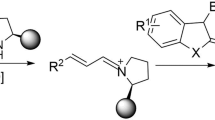Abstract
Tandem asymmetric double Michael addition/internal nucleophilic substitution of the novel chiral source, 5-(l-menthyloxy)-3-bromo-2 (5H)-furanone with nucleophilic alcohol compounds has been investigated. The tandem asymmetric reaction can afford four new stereogenic centers with one reaction and give optically pure spiro-cyclopropane derivatives 5a–5d which are difficult to obtain by routine methods. The synthetic method for 5a–5d was studied in de-tail and the new compounds were identified on the basis of their analytical data and spectroscopic data, such as [α]20, IR,1H NMR,13C NMR, MS and elementary analysis. The absolute configuration of the sprio [5-l-menthyloxy-3-bromobutyrolactocyclopropane-3”, 3’ (4’-methyloxy-5’-menthyloxybutyrolactone) ] (5a) was established by X-ray crystallography. The work can provide important synthetic strategy in synthesis of some new optically active spiro-cyclopropane analogues and some biologically active molecules with complex structure.
Similar content being viewed by others
References
Seyden-Penne, J.,Chiral Auxiliaries and Ligands in Asymmetric Synthesis, New York: John Wiley & Sons Inc., 1995, 43.
Wang Yuhai, Chen Qinghua, Studies on the synthesis of novel chiral compounds of purine and pyrimidine bases,Science in China (in Chinese), Ser. B, 1998, 28(6): 531.
Van Oeveren, A., Jansen, J. F. G. A., Feringa, B. L., Enantioselective synthesis of natural dibenzybutyrolacton lignans (-)-enteroctone, (-)-hinokinin, (-)-pluviatolide, (-)-enterodiol and furofuran lignan(-)-eudesmi via tandem conjugate addi- tion to γ-alkoxybutenoides,J. Org. Chem., 1994, 59: 5999.
Feringa, B. L., De Jons, J. C., New strategies in asymmetric synthesis based on γ-alkoxy butenolides,Bull. Soc. Chim. Belg., 1992, 101(7): 627.
Chen, Q. H., Geng, Z., Huang, B. et al., Synthesis of a new ehiral source 5-(l-metnhyloxy)-2(5H)-furanone and the study of asymmetric Michael addition reaction,Youji Huaxue (Organic Chemistry) (in Chinese), 1991, 11: 494.
Chen Qinghua, Zhou Chang, Industrial synthesis of optically active compounts,Youji Huaxue (Organic Chemistry) (in Chinese), 1994, 14: 1.
ChenQinghua, Geng Zhe, A new chiral source optically pure 5-(l-menthyloxy)-3, 4-dichloro-(5H)-furanone, its synthesis and structure,Acta Chimica Sinica (in Chinese), 1993, 51: 622.
Chen Qinghua, Geng Zhe, Huang Bin, Synthesis of enantiomerically pure 5-((l-menthyloxy)-3,4-dibromo-2(5H)-furanone and its tandem asymmetric Michael addition-elimination reaction,Tetrahedron: Asymmetry, 1995, 6: 401.
Farina, F., Maestro, M. C., Martin, M. R. et al., Pseudoesters and derivatives. XXIII—Reaction of 3-bromo-5- methoxyfuran-2(5H)-one with nucleophiles,Tetrahedron, 1986, 42(13): 3715.
Huang, H., Chen, Q. H., Synthesis of diastereomerically pure spiro-cyclopropane derivatives containing multichiral centers,Tetrahedron: Asymmetry, 1998, 9(23): 1403.
Author information
Authors and Affiliations
Corresponding author
Additional information
Project supported by the National Natural Science Foundation of China (Grant No. 29672004).
Rights and permissions
About this article
Cite this article
Huang, H., Chen, Q. Synthesis of spiro-cyclopropane derivatives containing multiple chiral centers. Sc. China Ser. B-Chem. 42, 268–276 (1999). https://doi.org/10.1007/BF02874242
Received:
Issue Date:
DOI: https://doi.org/10.1007/BF02874242




